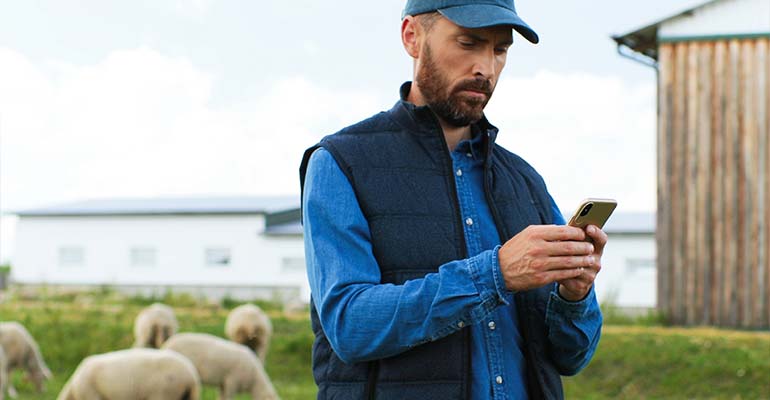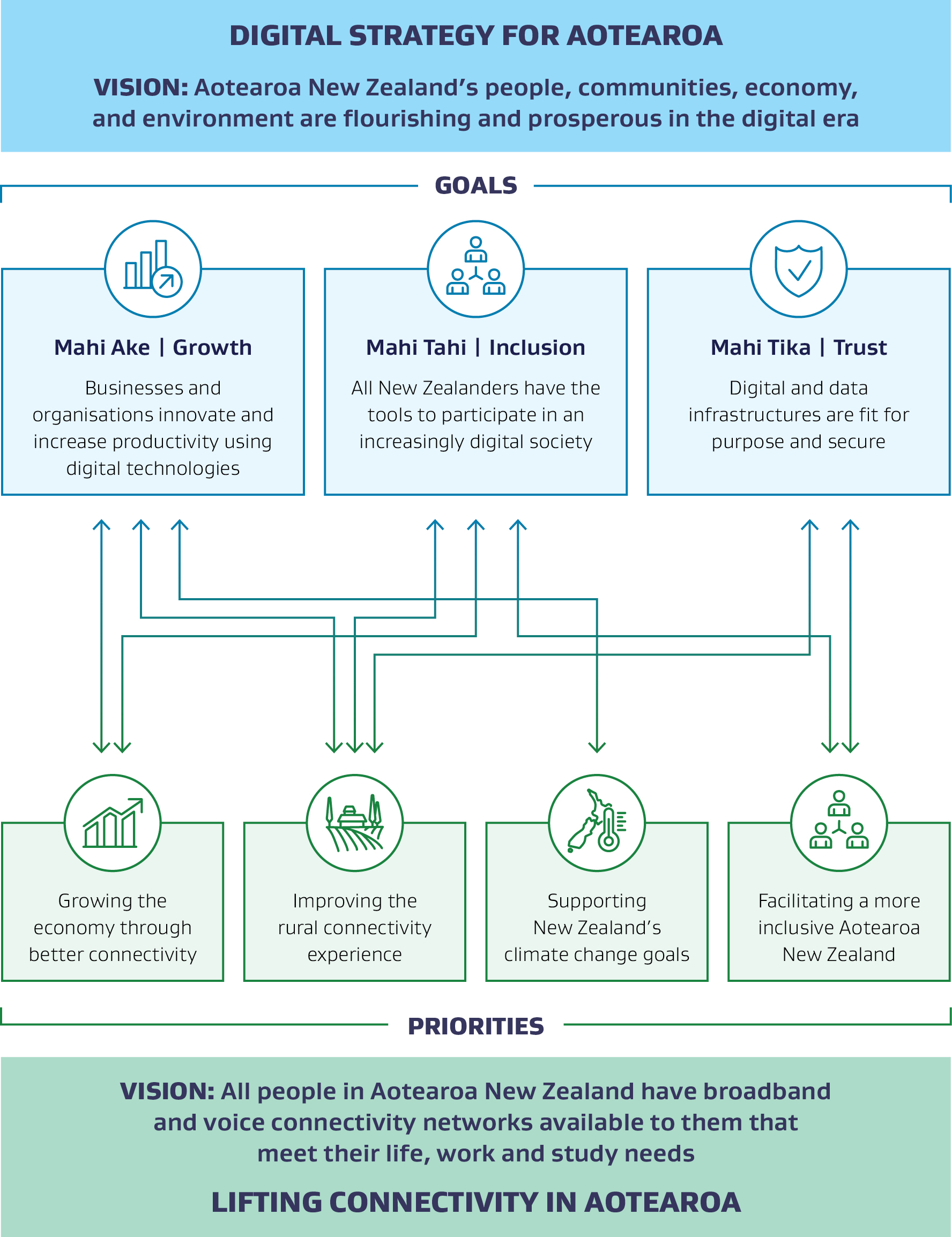Our Vision for 2032
All people in New Zealand have broadband and voice connectivity networks available to them that meet their life, work and study needs.
On this page
What would 2032 look like if we reached this vision?
A connected and inclusive community
As articulated in the Digital Strategy for Aotearoa, being able to participate digitally is essential for inclusion in modern societies and economies, providing a wealth of opportunities to foster learning, innovation and creativity. Having access to a reliable and secure internet connection or mobile data functionality is a foundational component towards achieving the aims of the Digital Strategy for Aotearoa, particularly the Mahi Ake - Growth and Mahi Tahi - Inclusion themes.
Our vision for 2032 is that all people in New Zealand should have broadband and voice connectivity networks available to them that meet their life, work and study needs.
To realise this vision we need to ensure that people can access reliable, secure connectivity infrastructure that serves the needs of the country. Having access to connectivity networks means that people will have the opportunity to conduct business, learn, adapt, and gain new digital skills throughout their lives.

Connectivity supports learning, connection and wellbeing
We know that access to connectivity supports people to stay connected to whānau and the wider community. Even when living or working alone, people can feel connected and included in the community through being able to talk with whānau, friends, colleagues or other members of society online or on their phones. Digital connectivity supports New Zealanders to readily share information, and digitally access health, education, entertainment and other services they need to live enjoyable, healthy and fulfilling lives.
Connected, innovative rural businesses well positioned to sell to the world
Reaching our vision will mean that access to connectivity networks will enable those working in the primary sector to better meet the expectations of more environmentally aware and ethically conscious consumers and trading partners. The use of remote sensors will better enable smart farming, increasing productivity through more efficient use of resources. Better connectivity will also allow for more efficient tracking and tracing of stock, produce and other products domestically and overseas, thereby assisting with Aotearoa New Zealand’s domestic and international climate change commitments, animal welfare requirements, country of origin requirements, and biosecurity measures.
The ability to do more online allows those working in rural areas to make more efficient use of their time by reducing the number and length of trips to make contact with suppliers and customers.
Importantly, the use of online technologies further reduces energy use and greenhouse gas emissions.
Innovative, diverse and competitive businesses
Reaching our 2032 vision will also mean that all businesses and organisations are able to use digital technologies and data to improve productivity, innovate and solve problems no matter where they are in Aotearoa New Zealand. Distance from markets or large centres of population will be much less of a barrier to being competitive when doing business relative to the business landscape of today.
Aotearoa New Zealand’s world-class connectivity will enable business and the tech sector to grow and develop a more diverse and exciting range of products, services and intellectual property to sell here and overseas. Increasing sales in the “weightless exports” sector (knowledge, ideas and online software) provide well-paid, fulfilling jobs, less encumbered by the tyranny of distance or concerns of carbon emissions associated with long-distance transportation.
Four priorities support the vision for digital connectivity
Our vision for 2032 is anchored by 4 priorities. These priorities reflect, and are complementary to, broader priorities and other work programmes across government to ensure Aotearoa New Zealand thrives in the digital era.
Growing the economy through better connectivity
Even before the COVID-19 pandemic, the trend towards an increasing reliance on digital technology to enable businesses to be more productive, innovative, and reach more customers was well underway.
Various local and international studies have demonstrated greater coverage and access to higher speed broadband leads to economic growth, and ultimately growth in a country’s GDP. Organisations such as the World Bank have identified that access to internet-based technologies can help workers carry out tasks more efficiently and to a higher standard, while also providing a greater ability to gain exposure to new markets, find new customers, and access a greater volume and quality of information.
Improving the rural connectivity experience for current and future needs
People living in rural and remote areas of Aotearoa New Zealand have significant connectivity needs. The comparative remoteness of rural areas and distance from both neighbours and from the full array of services urban centres enjoy, makes the ability to connect online important.
People in rural areas need to be able to access vital services and carry out activities such as remote learning and access to telehealth services. Improved connectivity will also facilitate the kinds of environmental and provenance reporting that will ensure market premium for our export products. Improving the rural connectivity experience does not mean having the same infrastructure or service performance as urban areas. It means being able to undertake many of the same activities including streaming, teleconferencing, accessing services online, filling in online forms, and uploading and downloading files. Performance similar to that offered at the higher-end of what 4G can provide, could be a sufficient solution for many needs, however it is likely that this could change over time.
Supporting New Zealand’s climate change goals
Climate change is a global emergency that goes beyond national borders. It is an issue that requires international cooperation and coordinated solutions at all levels.
To tackle climate change and its negative impacts, world leaders at the UN Climate Change Conference in Paris on 12 December 2015 agreed to substantially reduce global greenhouse gas emissions to limit the global temperature increase in this century to well below 2 degrees Celsius while pursuing efforts to limit the increase even further to 1.5 degrees.
As its contribution, New Zealand has several greenhouse gas emissions reduction targets, including to reduce our net greenhouse gas emissions to below 50 per cent of our 2005 levels by 2030.
New Zealand also has domestic targets of having net zero of all greenhouse gas emissions (other than biologically generated methane) by 2050, and at least a 10 per cent reduction in biologically generated methane emissions (from 2017 levels) by 2030.
Multiple organisations, including the World Bank, World Economic Forum and the Centre for Climate Change and Energy Solutions (C2ES) have reported on ways modern digital connectivity can reduce greenhouse gas emissions. Such means include:
- Enabling greater use of innovative ‘smart farming’ approaches (such as precision agriculture technology that enables better use of resources such as fertilisers, sensors, better data analytics, and better monitoring and management of animal health, which could enable smaller similarly productive herd sizes)
- Reducing the number of short journeys taken by carbon-emitting vehicles and increasing the viability of newer, safer and more efficient electric vehicles (potentially including autonomous vehicles, which are likely to be more dependent on 5G-type technologies)
- Reducing the energy consumption of sending and receiving data, and with it, emissions from non-renewable energy generation sources.
Facilitating a more inclusive Aotearoa New Zealand
In an increasingly digital world, digital inclusion has become essential for participation in our modern society and economy. Being digitally included allows people to connect with friends and whanau, to express their cultural identity, learn, create, and share new ideas, as well as access job and business opportunities, and goods and services.
There are 4 interdependent elements that are needed for a person (or community) to be digitally included: motivation, access, skills and trust.
The access component of digital includes suitable connectivity infrastructure being available, so that people and communities can access quality internet and communication services.
The Digital Inclusion User Insights report by the Department of Internal Affairs user insight group noted the performance of internet in rural areas was a barrier to economic development and participation in the digital economy. Participants also noted that improved connectivity could also serve as a useful tool to promote Māori culture and wellbeing.
The provision of suitable connectivity infrastructure is the focus of the Statement of Intent in Lifting Connectivity in Aotearoa.
How the vision and priorities support the Digital Strategy for Aotearoa
As illustrated below, the vision and priorities associated with the Lifting Connectivity in Aotearoa Strategy correspond to the vision and goals of the Digital Strategy for Aotearoa.

Text description
The roles the government will play in supporting the vision
Good connectivity is increasingly important for everyone, no matter where they work, live or study.
Much of the telecommunications connectivity infrastructure that serves Aotearoa New Zealand is owned and operated privately. However, recognising that there are parts of Aotearoa New Zealand that are not economically viable for private operators to provide services to, and there are some functions that only the government can perform, the government envisages having the following roles:
Supporter
Supporting the private sector to provide infrastructure to areas where it would otherwise be uneconomic for the private sector to build, operate and maintain that infrastructure.
Enabler
Enabling involves the government working to help remove barriers to the provision of connectivity infrastructure. This role can include assisting a faster roll-out of new technologies with significant long- term benefits to Aotearoa New Zealand but that involve a level of investment or risk that is beyond the capacity of private network operators to carry.
Educator
Working with others to:
(a) raise awareness of innovative solutions that can meet the needs of consumers (such as through the proposed Remote Users Scheme); and
(b) trial technology or approaches to test, understand, or demonstrate its usefulness to Aotearoa New Zealand.
Regulator
Preparing, overseeing and enforcing the laws and regulations necessary for ensuring a well-functioning telecommunications market and to protect consumer interests. The government also has a role to play in reviewing laws, regulations and standards that are no longer fit for purpose and that result in poor outcomes, inefficient processes or unnecessary barriers.

